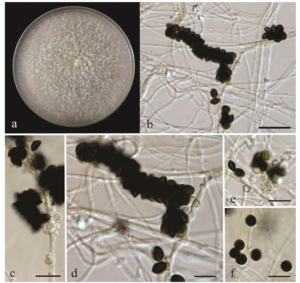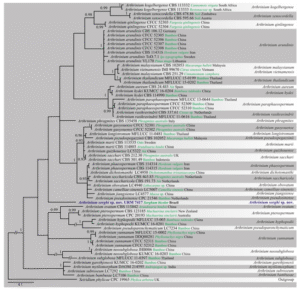Arthrinium sorghi J.D.P. Bezerra, C.M Gonçalves & C.M. Souza-Motta, sp. nov.
Index Fungorum number: IF 555795; MycoBank number: MB 555795; Facesoffungi number: FoF 05762; Fig. 48
Etymology: The name refers to the host plant, Sorghum bicolor, from which it was isolated as an endophyte.
Holotype: URM 93000.
Endophyte from leaves of Sorghum bicolor. Sexual morph: Undetermined. Asexual morph: Hyphae hyaline, branched, septate, 2–4 μm diam. Conidiophores erect or ascending, simple, straight or flexuous, 28–50 × 5 μm, or reduced to conidiogenous cells. Conidiiogenous cells aggregated in clusters on hyphae, hyaline, cylindrical to subcylindrical, 3–5 × 3–4 μm. Conidia brown to dark brown, smooth, globose, subglobose, with a longitudinal germ slit, 6–8 × 6–10 μm.
Culture characteristics: On PDA, colonies are flat, cottony, circular margin, sparse, aerial mycelium, surface and reverse white, reaching 90 mm after 7 d, conidia are produced after 30 d. On MEA, colonies are flat, cottony, aerial mycelium abundant, white surface, reverse yellowish, reaching 90 mm after 7 d.
Material examined: BRAZIL, Pernambuco state, Goiana municipality, isolated as endophyte from leaves of Sorghum bicolor, 25 August 2014, R.M.F. Silva (URM 93000, holotype); ex-type living culture, URM 7417.
GenBank numbers: ITS: MK371706; β-TUB: MK348526.
Notes: The ITS rDNA sequence of Arthrinium sorghi demonstrated 93% identity with sequences of A. pseudosinense (CPC 21546, GenBank: KF144910) and A. ovatum (CBS 115042, GenBank: NR_121558), and 88% identity with a sequence of A. phaeospermum (CBS 114314, GenBank: KF144904). The β-TUB sequence also showed 87% identity with the sequence of A. phaeospermum (CBS 114314, GenBank: KF144996), 82% identity with the sequence of A. obovatum (LC4940, GenBank: KY705166), and 79% identity with the sequence of A. ovatum (CBS 115042, GenBank: KF144995). The β-TUB sequence was not included in the phylogenetic analysis, but it is available to verify its relationship to sequences from other Arthrinium species. The phylogenetic analysis (Fig. 49) using ITS rDNA sequences, placed A. sorghi as an unique lineage within the genus Arthrinium. Morphologically, A. sorghi resembles A. pseudosinense, A. ovatum and A. phaeospermum but differs from them by the culture charcteristics, conidiophores, and conidia size, and by lacking a sexual morph which is
reported in A. pseudosinense (Crous and Groenewald 2013).

Fig. 48 Arthrinium sorghi (URM 93000, holotype). a Colony on PDA after 7 d at 25 ± 1 °C. b Conidiophore and conidial bunch. c–e Conidial bunch, conidiophores, and conidiogenous cells giving rise to conidia. f Conidia. Scale bars: b = 25 µm, c–f = 10 µm

Fig. 49 Bayesian inference tree based on ITS sequences representing Arthrinium. Bayesian posterior probabilities ≥ 0.93 are given near nodes. The tree is rooted with Seiridium phylicae (CPC 19965). The new species is in blue. Hosts or substrates are indicated in green
